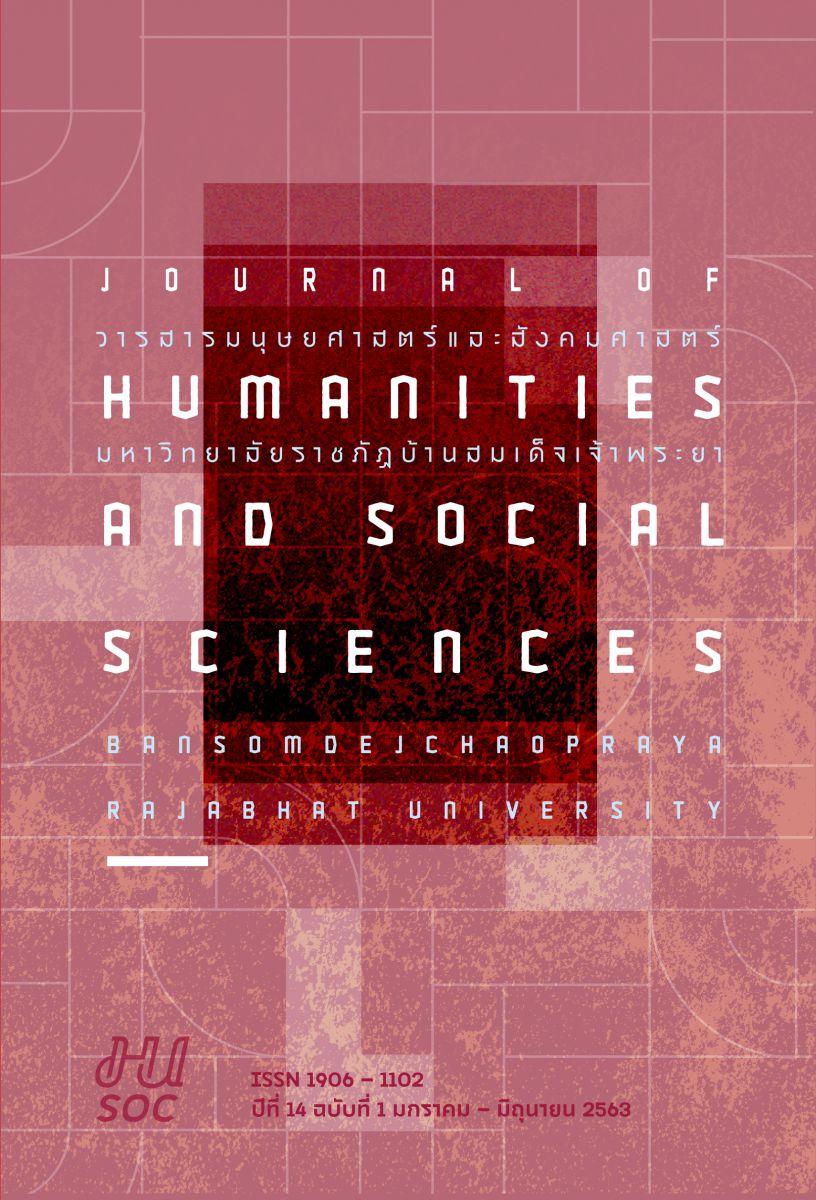A Study of Strong Community Management of Bang Nam Phueng Community Model
Keywords:
Community model, Strong communityAbstract
The objectives of this study were 1) to explore Bang Nam Pheung community development process which leads to a strong community of local leaders in Bang Nam Pheung Subdistrict Administrative Organization (SAO), Phra Pradaeng District, Samut Prakan, 2) to investigate the development process of award-winning and superior products, 3) to look into strategies of executing the community framework for entrepreneurs and tourists, and 4) to study the form of Bang Nam Pheung strong community management. The population of this study included 3 local leaders, 11 village heads, and 28 groups of community enterprise. Purposive sampling was used to select the samples from superior villages and groups of community enterprise. The samples included the Chief Executive of Bang Nam Pheung SAO, village heads of Moo 3, 10, and 11, and three superior enterprises of grain compresses, herbal incense, and homestay. The results showed that the Chief Executive of the SAO is visionary and democratic, and he always seeks participation from other leaders and people in every stage of the work processes such as making the community plan, following the framework, investing on and gaining from the plan, and evaluating and following-up with the activities. Moreover, the Chief Executive of the SAO has been an effective coordinator who brings support from both government and private networks within the country and from outside. For the product development process, the community works together as an organization which contains a clear structure and framework. There are frequent trainings and courses, development for modern and practical products, and just interest arrangement within the organization. Decentralization to villages and occupation groups is practiced by the Chief Executive of the SAO to make the regulations be followed by the members and tourists. The villages and the groups can set rules and regulations by and for themselves along with following the common regulations. Such participation creates members’ mutual responsibility to make tourists and themselves abide by such rules and regulations for peacefulness and sustainability.
References
กังสดาล กนกหงส์. (2557, มกราคม – มิถุนายน). การศึกษาและพัฒนากระบวนการเรียนรู้เพื่อเพิ่มศักยภาพการบริหารจัดการศูนย์ร้านค้าสาธิตชุมชนอย่างยั่งยืน ตำบลปงยางคก อำเภอห้างฉัตร จังหวัดลำปาง. วารสารศิลปศาสตร์ มหาวิทยาลัยสงขลานครินทร์. 6(1), 106-120.
กันยาวรรนธ์ กำเนิดสินธุ์. (2558, มกราคม – มิถุนายน). การมีส่วนร่วมของประชาชนชุมชนบางน้ำผึ้งในการจัดการแหล่งท่องเที่ยวเชิงอนุรักษ์และวัฒนธรรม. วารสารสารสนเทศสำนักวิทยบริการและเทคโนโลยีสารสนเทศ มหาวิทยาลัยราชภัฏบ้านสมเด็จเจ้าพระยา. 16(1), 75 – 81.
กันยาวรรนธ์ กำเนิดสินธุ์. (2561). ศึกษาชุมชนต้นแบบการจัดการชุมชนเข้มแข็งของชุมชนบางน้ำผึ้ง. (รายงานผลการวิจัย). กรุงเทพฯ: มหาวิทยาลัยราชภัฏบ้านสมเด็จเจ้าพระยา.
กิตติศักดิ์ ปรกติ. (2550). สิทธิของบุคคลซึ่งนับรวมกันเป็นชุมชน. กรุงเทพฯ: สำนักงานศาลรัฐธรรมนูญ.
ธีระพงษ์ แก้วหาวงษ์. (2543). กระบวนการเสริมสร้างชุมชนเข้มแข็ง: ประชาคมประชาสังคม. ขอนแก่น: คลังนานาวิทยา.
ประพนธ์ ผาสุขยืด. (2541). ทางเลือกทางรอด. กรุงเทพฯ: เออาร์ อินฟอร์เมชั่น แอนด์ พับบิเคชั่น.
ประเวศ วะสี. (2542). ยุทธศาสตร์ชาติเพื่อความเข้มแข็งทางเศรษฐกิจ สังคมและศีลธรรม. (พิมพ์ครั้งที่ 2). กรุงเทพฯ: หมอชาวบ้าน.
เรวดี ประเสริฐเจริญสุข และนุศจี ทวีวงศ์. (2552). สิทธิชุมชนมิติประมงพื้นบ้าน. กรุงเทพฯ: มูลนิธิเพื่อการพัฒนาที่ยั่งยืน.
สนธยา พลศรี. (2547). ทฤษฎีและหลักการพัฒนาชุมชน. (พิมพ์ครั้งที่ 5). กรุงเทพฯ: โอเดียนสโตร์.
สำเนาว์ รัศมิทัต. (2561). นายกองค์การบริหารส่วนตำบลบางน้ำผึ้ง. (สัมภาษณ์, 18 มกราคม 2561).
เสน่ห์ จามริก. (2549). สิทธิมนุษยชนไทยในกระแสโลก. กรุงเทพฯ: สำนักงานกองทุนสนับสนุนการวิจัย.
Dubrin, A. J. (1998). Leadership: Research Findings, Practice and Skills. Boston: Houghton Mifflin.
Fox, A. K. (2013). The Concept of Community Development. Department of Economics and Sociology. Iowa: Iowa State University.
Lewin, K. (1939). The History of Leadership Studies and Evolution of Leadership Theories. Retrieved June 15 2016. https://toughnickel.com/business/The-History-of-Leadership-Studies-and-Evolution-of-Leadership-Theories.
Likert, R. (1967). The human organization: Its management and value. New York: McGraw - Hill.
Northouse, P. & Yukl, G. (2016). The History of Leadership Studies and Evolution of Leadership Theories. Retrieved June 13 2016. The-History-https://toughnickel.com/business/of-Leadership-Studies-and-Evolution-of-Leadership-Theories.
Schoenlaub, N. (2015). 8 Steps for Organizational Development Interventions. Retrieved July 17 2016. https://www.linkedin.com/pulse/8-steps-organizational-development-interven
tions-nicolas-schoenlaub.
Snell, J. (2009). Chaos Theory and Post Modernism. Lowa city: Kirkwood College.
Streeten, P. (1972). The Frontiers of Development Studies. London: Macmillan.
Stumpf, S. E. (1989). Philosophy: History and Problems. New York: McGraw - Hill.
Thai Government. (2016). Sufficiency Economy Philosophy: Thailand’s Path towards Sustainable Development Goals. Retrieved June 18 2016. http://tica.thaigov.net/main/contents/files/business/pdf.
Yukl, G. (1989). Leadership in organization. New Jersy: Prentice – Hall.
Downloads
Published
How to Cite
Issue
Section
License
Copyright (c) 2020 Faculty of Humanities and Social Sciences, Bansomdejchaopraya Rajabhat University

This work is licensed under a Creative Commons Attribution-NonCommercial-NoDerivatives 4.0 International License.




